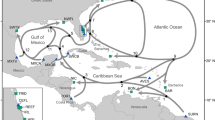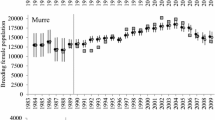Abstract
We studied the determinants of colony site dynamics in Audouin's gull, Larus audouinii, breeding in a small archipelago of the western Mediterranean. Data on island occupation were available for a series of 25 years, since first colonization of the archipelago in 1973. Group behavior was studied in relation to the components of dispersal: permanence or abandonment (extinction) on an island previously occupied and permanence or occupation (colonization) of another island. Generalized Linear Mixed Models (GLMMs) were used to identify the relative contribution of each explanatory variable to the probability of colony abandonment. Gulls showed a low probability (3%) of abandoning one of the islands (Grossa I.), especially when the colony was increasing in numbers from time t i-1 to t i . However, the probability of abandoning Grossa increased up to 31% when the colony was declining. The probability of island abandonment was very high for all other islands (range 66–99%) when the colony was declining, but much lower (range 36–82%) when it was increasing. Hence, we suggest that island abandonment by Audouin's gull is at least a two-step process. The first step (dispersal of a portion of the colony) probably takes place at random, as an evolutionary load typical of a species evolved in unstable habitats. The second step, a further loss of breeding pairs, seems to feedback on the first loss of members of the colony (public information), likely perceived as a loss of colony quality. Colonization of islands by gulls abandoning Grossa I. was marginally and negatively affected by the density of breeding yellow-legged gulls, a predatory species. Results apply to conservation ecology since they highlight the need to protect not only occupied patches but also those empty at present.


Similar content being viewed by others
References
Andreassen HP, Stenseth NC, Rolf AI (2001) Dispersal behaviour and population dynamics of vertebrates. In: Bullock JM, Denward RE, Hails RS (eds) Dispersal ecology. British Ecological Society, London, pp 237–256
Barbraud C, Nichols JD, Hines JE, Hafner H (2003) Estimating rates of local extinction and colonization in colonial species and an extension to the metapopulation and community levels. Oikos 101:113–126
Beletsky LD, Orians GH (1991) Effects of breeding experience and familiarity on site fidelity in female red-winged blackbirds. Ecology 72:787–796
Burger J (1982) The role of reproductive success in colony-site selection and abandonment in Black Skimmers (Rynchops niger). Auk 99:109–115
Clobert J, Danchin E, Dhondt A, Nichols JD (2001) Dispersal. Oxford University Press, Oxford
Coulson JC (1997) How do colonies form and grow? Do other species use the method in kittiwakes? Proceedings of the XI colonial waterbirds society annual meeting. Colonial Waterbirds Society, Lafayette, Calif., pp 39
Crawford RJM, Dyer BM, Brooke RK (1994) Breeding nomadism in southern African seabirds: constraints, causes and conservation. Ostrich 65:231–246
Cuthbert FJ (1988) Reproductive success and colony-site tenacity in Caspian terns. Auk 105:339–344
Danchin E (1992) The incidence of the tick parasite Ixodes uriae in kittiwake Rissa tridactyla colonies in relation to age of the colony, and a mechanism of infecting new colonies. Ibis 134:134–141
Danchin E, Boulinier T, Massot M (1998) Conspecific reproductive success and breeding habitat selection: implications for the study of coloniality. Ecology 79:2415–2428
Danchin E, Heg D, Doligez B (2001) Public information and breeding habitat selection. In: Clobert J, Danchin E, Dhondt AA, Nichols JD (eds) Dispersal. Oxford University Press, Oxford pp 243–258
Dieckmann U, O'Hara B, Weisser W (1999) The evolutionary ecology of dispersal. Trends Ecol Evol 14:88–90
Doligez B, Danchin E, Clobert J (2002) Public information and breeding habitat selection in a wild bird population. Science 297:1168–1170
Doligez B, Cadet C, Danchin E, Boulinier T (2003) When to use public information for breeding habitat selection? The role of environmental predictability and density dependence. Anim Behav (in press)
Erwin RM, Galli J, Burger J (1981) Colony site dynamics and habitat use in Atlantic coast seabirds. Auk 98:550–561
Erwin RM, Nichols JD, Eyler B, Stotts DB, Truitt BR (1998) Modeling colony-site dynamics: a case study of gull-billed terns (Sterna nilotica) in coastal Virginia. Auk 115:970–978
Ferrière R, Belthoff JR, Olivieri I, Krackow S (2000). Evolving dispersal: where to go next? Trends Ecol Evol 15:5-7
Forbes LS, Kaiser GW (1994) Habitat choice in breeding seabirds: when to cross the information barrier. Oikos 70:377–384
Forero MG, Donazar JA, Blas J, Hiraldo F (1999) Causes and consequences of territory change and breeding dispersal distance in the black kite. Ecology 80:1298–1310
Frederick PC, Bildstein KL, Fleury B, Ogdens J (1996) Conservation of large, nomadic populations of White Ibises (Eudocimus albus) in the United States. Conserv Biol 10:203–216
Hansson L (1991) Dispersal and connectivity in metapopulations. Biol J Linn Soc 42:89–103
Johnson CM, Krohn W (2002) Dynamic patterns of association between environmental factors and island use by breeding seabirds. In: Scott JM, Heglund PJ, Morrison ML (eds) Predicting species occurrences. Island Press, Washington, D.C., pp 171–181
Johst K, Brandl R (1997) The effect of dispersal on local population dynamics. Ecol Model 104:87–101
Kharitonov SP, Siegel-Causey D (1988) Colony formation in seabirds. In: Johnson RF (ed) Current ornithology. Plenum, New York, pp 223–272
Littell RC, Milliken GA, Stroup WW, Wolfinger RS (1996) SAS system for mixed models. SAS Institute, Cary, N.C.
Lurz PWW, Garson PJ, Wauters LA (1997) Effects of temporal and spatial variation in habitat quality on red squirrel dispersal behaviour. Anim Behav 54:427–435
Martínez-Abraín A, González-Solis J, Pedrocchi V, Genovart M, Abella JC, Ruiz X, Jiménez J, Oro D (2003) Kleptoparasitism, disturbance and predation of Yellow-legged Gulls on Audouin's Gulls in three colonies of the western Mediterranean. Sci Mar 67 (Suppl 2):89–94
McCullagh P, Nelder JA (1983) Generalised linear modelling. Chapman and Hall, London
Oro D (1998) Audouin's gull account. In: Ogilvie MA (ed) The birds of the western Palearctic, vol 2. Oxford University Press, Oxford, pp 47–61
Oro D (2002) Breeding biology and population dynamics of Slender-billed Gulls Larus genei at the Ebro Delta (western Mediterranean). Waterbirds 25:67–77
Oro D (2003) Managing seabird metapopulations in the Mediterranean: constraints and challenges. Sci Mar 67 (in press)
Oro D, Martínez-Vilalta A (1994) Factors affecting kleptoparasitism and predation rates upon a colony of Audouin's gull (Larus audouinii) by yellow-legged gull (Larus cachinnans) in Spain. Col Waterbirds 17:35–41
Oro D, Muntaner J (2000) La gaviota de Audouin Larus audouinii en el archipiélago de Cabrera. In: Pons GX (ed) Las aves del Parque Nacional marítimo-terrestre del archipiélago de Cabrera (Islas Baleares, España). GOB, Palma de Mallorca, pp 95–110
Oro D, Pradel R (1999) Recruitment of Audouin's gull to the Ebro Delta colony at metapopulation level in the western Mediterranean. Mar Ecol Progr Ser 180:267–273
Oro D, Pradel R (2000) Determinants of local recruitment in a growing colony of Audouin's gull. J Anim Ecol 69:119–132
Oro D, Ruxton GD (2001) The formation and growth of seabird colonies: Audouin's gull as a case study. J Anim Ecol 70:527–535
Oro D, Jover L, Ruiz X (1996) Influence of trawling activity on the breeding ecology of a threatened seabird, Audouin's gull Larus audouinii. Mar Ecol Progr Ser 139:19–29
Oro D, Pradel R, Lebreton JD (1999) Food availability and nest predation influence life history traits in Audouin's gull, Larus audouinii. Oecologia 118:438–445
Pärt T (1995) The importance of local familiarity and search costs for age- and sex-biased philopatry in the collared flycatcher. Anim Behav 49:1029–1038
Reed JM, Dobson AP (1993) Behavioural constraints and conservation biology: conspecific attraction and recruitment. Trends Ecol Evol 8:253–255
Serrano D (2003) El papel de las decisiones individuales en la estructura metapoblacional del Cernícalo primilla Falco naumanni. PhD thesis, University Autónoma, Madrid
Serrano D, Tella JL, Forero M, Donázar JA (2001) Factors affecting breeding dispersal in the facultatively colonial lesser kestrel: individual experience vs conspecific cues. J Anim Ecol 70:568–578
Smith AT, Peacock MM (1990) Conspecific attraction and the determination of metapopulation colonization rates. Conserv Biol 4:320–323
Spear LB, Pyle P, Nur N (1998) Natal dispersal in the western gull: proximal factors and fitness consequences. J Anim Ecol 67:165–179
Stamps JA (2001) Habitat selection by dispersers: integrating proximate and ultimate approaches. In: Clobert J, Danchin E, Dhondt A, Nichols JD (eds) Dispersal. Oxford University Press, Oxford, pp 230–242
Suryan RM, Irons DB (2001) Colony and population dynamics of black-legged kittiwakes in a heterogeneous environment. Auk 118:636–649
Switzer PV (1993) Site fidelity in predictable and unpredictable habitats. Evol Ecol 7:533–555
Switzer PV (1997) Past reproductive success affects future habitat selection. Behav Ecol Sociobiol 265:253–260
Wiklund CG (1996) Determinants of dispersal in breeding Merlins (Falco columbarius). Ecology 77:1920–1927
Acknowledgements
This study is contribution no. 10 to the LIFE-NATURE program BA 3200/98/447 "Conservation of island Special Protection Areas in the Valencian Region" financed by the Generalitat Valenciana and the European Union. We thank all the wardens from the Columbretes Nature Reserve for their anonymous work and Juan Jiménez for his support over all these years. R. Ricklefs, E. Cam, J.A. Donázar, D. Serrano, T. Sota and two anonymous referees critically read drafts of the manuscript. M.G. Forero was financed by a contract of the Program Ramón y Cajal of the Ministerio de Ciencia y Tecnología of Spain.
Author information
Authors and Affiliations
Corresponding author
Appendix
Appendix
Values for a number of variables used for analyzing patch extinction and colonization of Audouin's gull at the Columbretes archipelago. The area, vegetation cover and protection against human disturbances are shown for each patch (i.e. island or colony). For each year and patch, number of breeding pairs is shown during the period 1973–2002 and its breeding success (when available, as mean number of fledglings per pair) in brackets. Data for 1976, 1979, 1980, 1981 and 1982 were not available. AG Total number of Audouin's and YLG yellow-legged gulls (in number of pairs) in the archipelago (NA not available).
Rights and permissions
About this article
Cite this article
Martínez-Abraín, A., Oro, D., Forero, M.G. et al. Modeling temporal and spatial colony-site dynamics in a long-lived seabird. Popul Ecol 45, 133–139 (2003). https://doi.org/10.1007/s10144-003-0150-z
Received:
Accepted:
Published:
Issue Date:
DOI: https://doi.org/10.1007/s10144-003-0150-z




